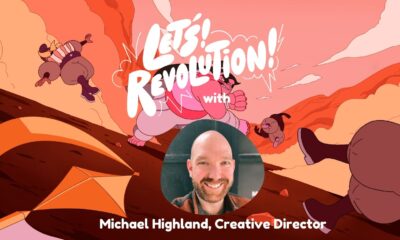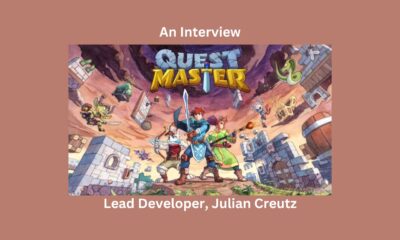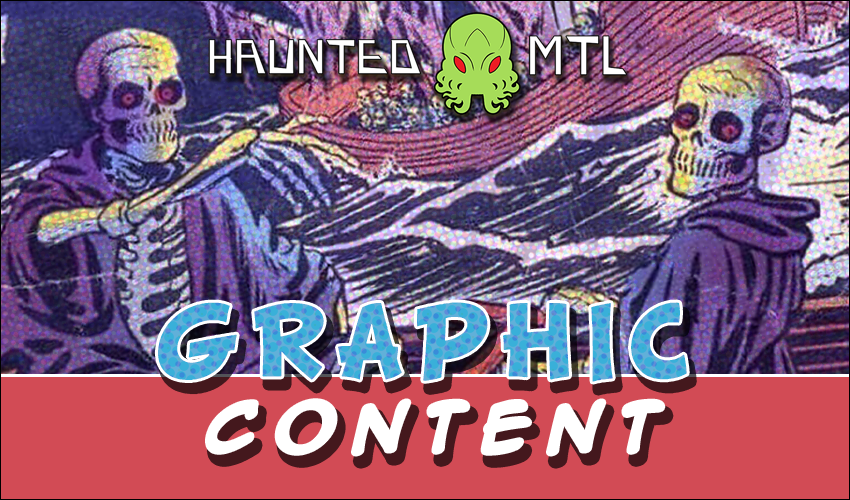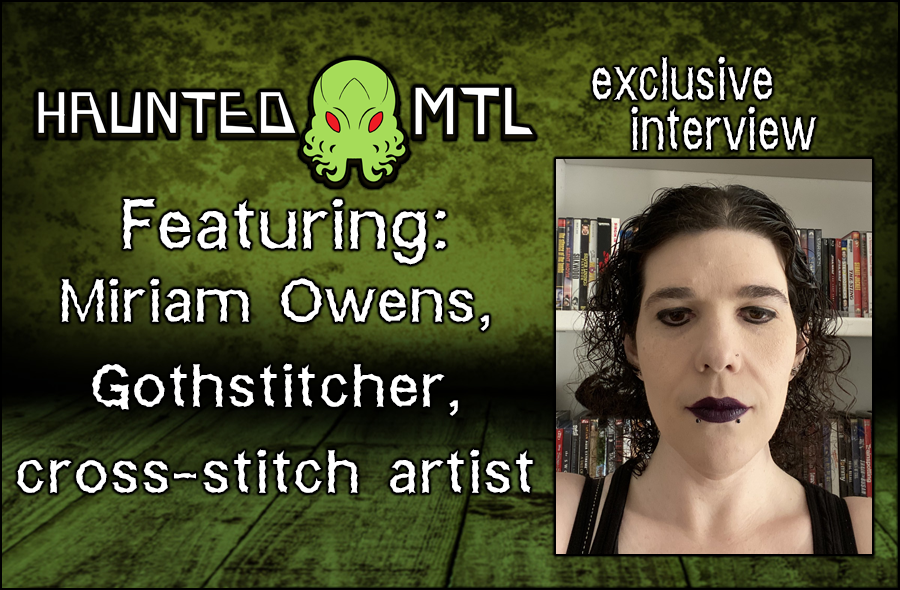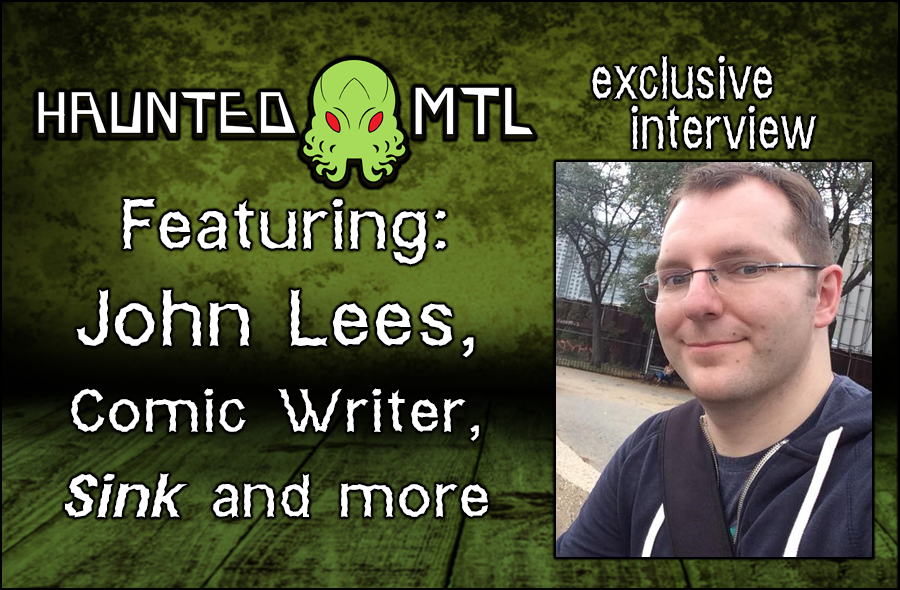
Interview: ‘Sink’ Writer John Lees
More Videos
Published
3 years agoon
We’re very excited at Haunted MTL to reach out to the horror community and spotlight creative and talented folks where we find them. We love to add to our interview series when we can, and Haunted MTL is fortunate to have a fantastic interview this week with writer John Lees, the mind behind one of our favorite comics, Sink – one of the more beloved series reviewed by our very own comic obsessed David Davis.
John Lees talks to us about the origins of Sink, his influences on the comic, and even provides valuable insight to anyone wanting to create comics themselves.
Sink Writer John Lees Interview
Haunted MTL: How did Sink first come to mind? Was this a concept that was developing for a while, or did it hit you suddenly?
John Lees: I think it’s a combination of both. The general idea of Sink is something I had in my head as wanting to do long before I did it. Scalped is one of my all-time favourite comics, and I had this idea of wanting to do my own take on a heavily location-driven crime saga, but mine would be set in Glasgow, and have more of a horror twist. I wasn’t sure if it would be something I’d eventually do with Iain Laurie, after we’d worked on And Then Emily Was Gone together, or what exact form it would take, so it was kinda in the back-burner in my brain for a couple of years. But once I made the decision I wanted to do it, it fell into place really quickly. Mr. Dig, Florence Kilcolm, Si McKirdie, the Dickheads, Busman Boab, the blue van clowns… Sinkhill took shape so quickly and so clearly in the way that happens with the stories you know are going to be special.
HMTL: How soon had you figured out Mr. Dig’s identity and story arc through the first two volumes? In a lot of ways, his story ends up feeling central to many of the themes expressed over the course of the first two volumes. Was this something intended from the start or discovered on the way?
JL: Oh, I knew Mr. Dig’s identity from the moment I first wrote him. If you look back to his first appearance in Sink #1, Mr. Dig says, “Fuck off back to where you came from” to Allan. When I wrote that, it was with the thought that he’d have the same line thrown at him by some racist asshole at a later point in the series, which we see happen in Sink #8. And having studied teaching English to speakers of other languages in the past, I’d previously done language profiles on how Kurdish speakers adapt to speaking English and some common recurring mistakes, hence why Mr. Dig drops definite and indefinite articles like “a” or “the” in his speech, something else which was part of his dialogue from the very beginning. As far as more overarching themes, the idea of Sink being a world where the protagonists are largely the kind of people who don’t get to be heroes in these types of stories is something that came together partly by design and partly by happy accident.
HMTL: How did you get Alex Cormack involved with the project? Was it something along the lines of, “hey, man, want to draw this hyper-violent crime book?”

JL: I’d already worked with Alex before. We’d done a short together, then had worked together at greater length on Oxymoron: The Loveliest Nightmare for ComixTribe. I was (and still am) continually in awe of his art, and on top of that, he’s just such a lovely guy, we immediately got on. And so, after we finished with Oxymoron, we’d been talking about how we should try working on something else together, something of our own rather than playing in someone else’s sandbox. And we’d thrown around a couple of ideas, but nothing was really clicking. And I had this Sink idea in my back pocket, but like I said, I’m thinking maybe this is an Iain book, maybe it’s just a bunch of loosely connected one-shots we release at Scottish conventions (which is where the anthology format idea originated, I believe). But then something clicked where I thought, hang on, why couldn’t this be an ALEX book? And that instantly changed the dynamics at play, I started imagining it less as pure psychological horror (though there are certainly still elements of that in there!) than as this genre-mashup with pulp crime and bombastic action elements, and really pushing the gore-drenched aesthetic of Oxymoron to new levels. And thankfully, when I then said to Alex, “Hey, man, want to draw this hyper-violent crime book?”, he was instantly down for the idea!
HMTL: How has the reception to Sink been in Glasgow among locals? What elements do they recognize in Sinkhill?
JL: Whenever I’ve had Sink on sale at Scottish shows, the reception has been really positive. In my experience, Scottish comic readers have been really supportive of Scottish indie creators, all the more so when the stories themselves are Scottish. And so, readers have enjoyed all the Glasgow elements. That was a balance I was hoping to pull off while writing Sink. I wanted it to be somewhat universal, where readers from anywhere could enjoy it, but if you’re someone who’s from Glasgow, who recognizes some of the landmarks or local in-jokes, then you’ll have another level of appreciation for the comic.
HMTL: Do you feel Sink is a good introduction to your body of work, or would you steer readers to a different book, like And Then Emily Was Gone?
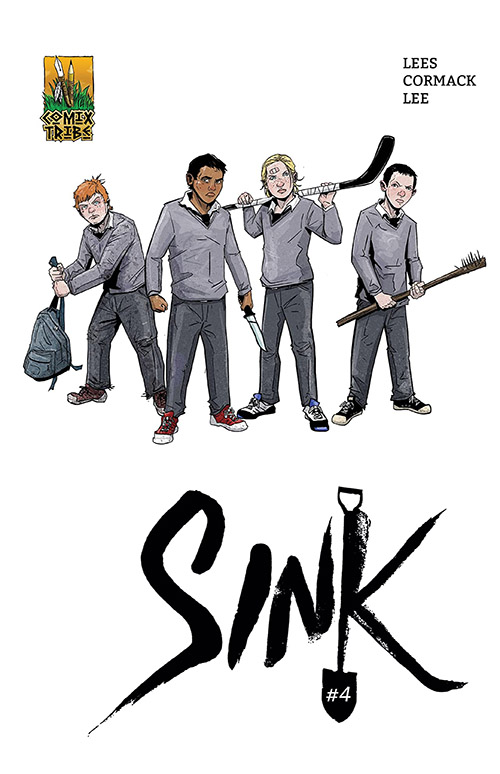
JL: I think any of my comics is a good introduction to my body of work, as I want people to spend money on all of them! And the cool thing is, I’ve had readers say Mountainhead was their first introduction to me, that Hotell was their first introduction, that The Crimson Cage was their first introduction, and then my older stuff is there waiting for them to discover. But Sink is a comic that’s particularly close to my heart. It’s a twisted love letter to my home city of Glasgow, and because of the broad range of tones, it manages to capture a wide variety of things I enjoy writing: horror, comedy, stories with heart and emotion, even some almost superhero-type stuff.
HMTL: The horror and crime angle of Sink is quite interesting. What drives you to write about horrific crimes?
JL: Ha! That question makes me sound disturbed! I’ve always been a fan of horror, as a reader and as a viewer, which I guess translates into also enjoying writing it. But I’d also say that I enjoy the challenge of getting into the mindsets of characters in the most extreme of situations. I think it might have been David Lynch, or maybe someone writing about David Lynch, that used the phrase “the twilight zone between crime and horror” when talking about Blue Velvet. The idea of this phrase is that, what might from one perspective be a crime procedural could be a horror from another perspective, if you’re grounded and right in there with the person experiencing that crime. I think it’s down to the empathy, and how much you want the readers to feel for the characters these horrific crimes are happening to.
HMTL: One element of Sink is that you really establish a consistent sense of place. A horrible place, but well developed. As a writer how do you establish a setting in such detail?
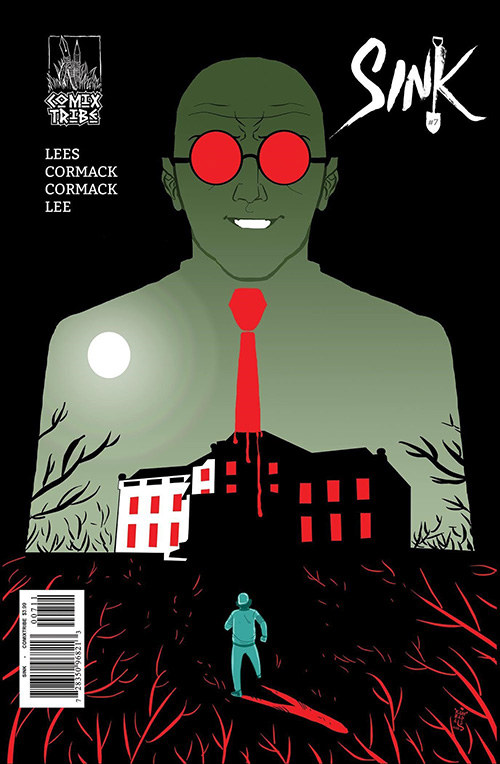
JL: Sinkhill is a fictional district within Glasgow, but Glasgow itself is a real city. And I think it helps, in my head, being able to know the actual city so well, and for me to be able to picture a particular road junction, and imagine, “Okay, if you take a left here, that takes you into Sinkhill.” It makes the place feel almost real. And it probably helps that there are shadows of various real place that form the genetic make-up of Sinkhill. I mean, it’s a running joke between me and Alex that, for being a place that ultimately is likely not much bigger than a few blocks, there are so many varied landmarks to be found here. What the heck would a map of Sinkhill look like?! But the more stories we tell in this world, the more lived-in this location becomes, and the more we’re able to pluck familiar locales from past stories and recycle them for new ones, just adding to that feel that this is all taking place in the same setting and these tales are all connected.
HMTL: When putting together the setting and the stories, do you have a system in place for keeping everything mapped out? A story bible? A wiki?
JL: I’ll plan out issues, and I’ll broadly map out plans for each volume. But in terms of big picture mythology, I don’t have anything so sophisticated as an official story bible. Maybe I should! I largely keep it all in my head, and I do sometimes worry about forgetting a plot point from an earlier issue, or re-using a character name!
HMTL: When it comes to inspiration for certain stories you mention a few, but I am curious how that works. For example, do you have a rough idea in mind, which reminds you of a movie and you watch it to help shape your approach? Or is it something where you watch or read something and think ‘how can this become a Sink story?’
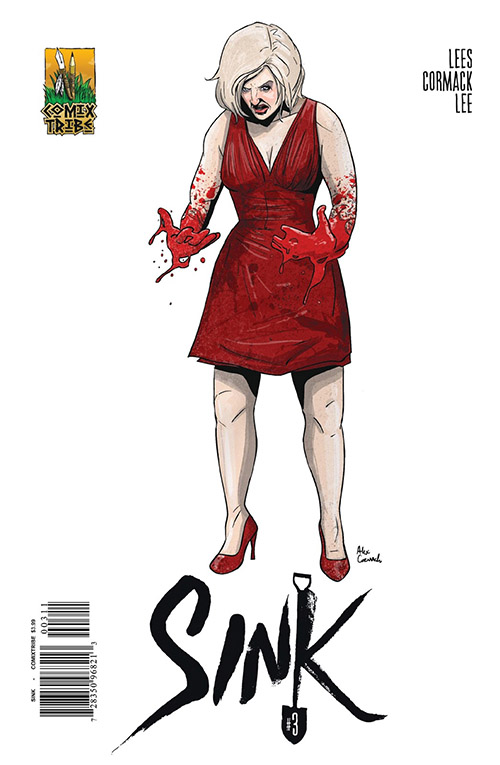
JL: It varies. I think there are two types of Sink Tale. There are lore tales, where I’m putting in the work to add to the tapestry and build on the larger overarching mystery connecting the main players of the series. Then there are the standalone tales, the little one-shot vignettes of life in Sinkhill. With the lore tales, maybe I’m approaching with the mindset of “I need this character to get from point A to point B to enter the next phase of their arc, how can I get them there?” And with the standalone tales, often it can be me building on fragments – a character, say, or a scenario – which in itself might not have been able to sustain a full series, but when inserted into the world of Sink, becomes more fully realised. Like, with Sink #10, I’d had the idea of a twisted romantic comedy about a couple doing BDSM who end up in a mad home invasion scenario, but that’s not a series, it’s a sketch. Putting Kieran and Louise into Sinkhill, though, and you can then feed it into the wider mythology, and it becomes more substantial, and now that’s probably my favourite issue of the series so far.
HMTL: Kieran and Louise’s story was absolutely hilarious and an interesting way to end the second volume, especially given the catharsis and culmination of the end of the two-parter “Graphite Green.” Was the placement of “Bedbug” afterward purposeful?
JL: The placement was absolutely intentional. My thinking was, “Graphite Green” was our biggest Sink story yet, this epic two-part saga that was action-packed and climactic in its own right, while also setting up some major big picture stuff for down the line. And so, I figured it would be nice to then wrap up the volume with a little palette cleanser, something more light and fun, at least by Sink standards. I also liked the idea of each volume having a “happy ending,” comparatively speaking, of course. And underneath all the violence and butt toys, I think the story of Kieran and Louise is quite sweet and wholesome, and hopefully, if we’ve done our jobs, you’re invested in them on a human level and are happy to see them not just survive, but for their relationship to blossom.
HMTL: Can you tell us a little bit about ComixTribe? Did you help establish the publisher or were you brought in to work with them with Emily?
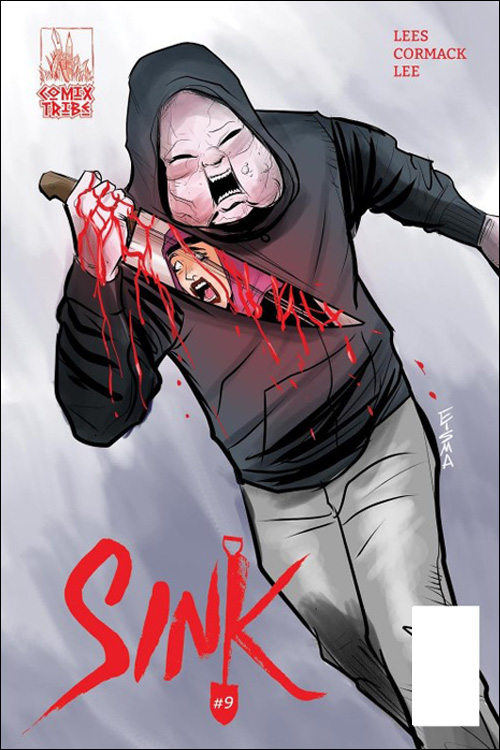
JL: I didn’t establish the publisher. It’s run by the great Tyler James. But I have been around with them since the beginning. My first ever comic, a superhero story called The Standard, was edited by my original comics mentor, Steven Forbes. He was working with Tyler on the formation of ComixTribe back at the time, this would be going back to 2011, and had suggested to me that we bring The Standard into the ComixTribe fold to be part of the fledgling publisher’s launch line-up. And I’ve worked with them ever since. They published And Then Emily Was Gone, and now they’re publishing Sink.
HMTL: With Dig #1 on the way, it is clear that you have more stories to tell about Sinkhill and its residents. Is there anything lined up after Dig? Another volume of Sink?
JL: Oh, we definitely want to do more. Over the last couple of years, I actually wrote out the entirety of both Volumes 3 and 4! The original plan had been for Alex and I to take a year off of Sink after the release of Volume 2 in 2019, do The Crimson Cage in 2020, then come back for Sink Volume 3 in 2021. But then the pandemic happened, and The Crimson Cage got pushed back to launching in December 2021, making it mostly a 2022 book. And that in turn impacted on Sink, meaning that Dig was pushed back to early 2022 and Sink Volume 3 to mid-2022. But with the global paper shortage and other factors, Dig ended up being moved back to mid 2022, and Volume 3 is now looking like late 2022, or maybe early 2023. But we definitely still have more stories that we want to tell, and we will get them to you as soon as we’re able!
HMTL: For people who want to create their own comics, what three suggestions do you have to help them get started or move forward in their careers?
JL: Suggestion 1: finish something. I think one of the biggest early pitfalls you see a lot of writers going through is that they become serial first issue writers, where they’ll write something, then get stuck or bored, so they start a new idea. I’m not able to do it so often now, but in the past, I would frequently have the entirety of a comic series written before a publisher had picked it up or before art had even begun. Because, especially early on, I think finishing is a VITAL skill. The beginning of a story is exciting and full of possibility, sure. But it’s getting through that middle, muddling through the process of figuring how all the component parts of your narrative click into place, where you really start building your plotting muscles. And writing THE END at the bottom of your final script will give you such a boost, such a feeling of achievement and a confirmation that you CAN tell a story in full. On a related note, so I guess this would be suggestion 1A, hold off on redrafting a script until you’ve finished your first draft. It’s so easy to get yourself stuck in a rut by not being happy with a scene you’ve written, and going back to tinker with it, and the script never gets done. Write out the script first, even if your brain is telling you that you’re writing garbage, just to get it down on the page, have something concrete to work with. Then, one you have a full script, you can get to going back and refining it and making it better.
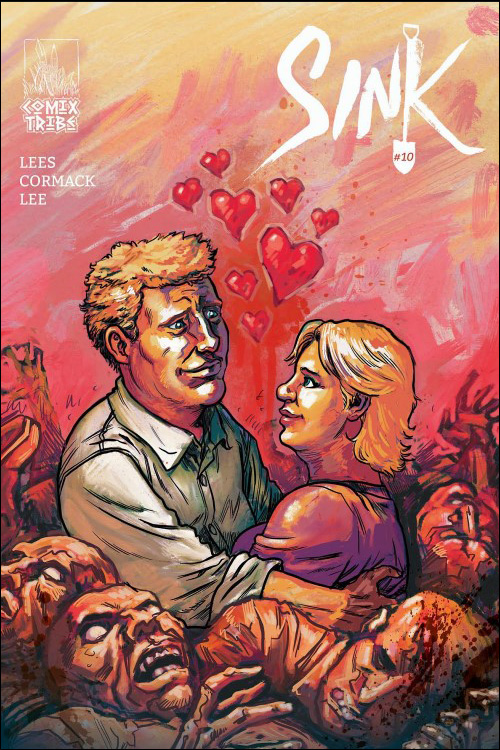
Suggestion 2: find a peer review group. Something that has helped me immeasurably over the years is being a founding member, and later the leader, of the Glasgow League of Writers, a writer’s circle for comics where we meet monthly and review each other’s comic scripts. Over the years, I’ve been a part of that group, and a couple of other peer review groups. Writing is a lonely pursuit, often done in a vacuum, and we can get too close to our own stuff, not being able to see stuff that’s wrong. If you can gather a community of like-minded creative people you trust – be it online or in person – to share your work with, not only will you improve as a writer (both in terms of the advice you get from them, and in the advice you give in turn making you think more critically), but you’ll also gain a community. And even if getting to the point of actually getting your comic made is some way away, knowing you’re writing for an audience can give you that added drive and motivation to create.
Suggestion 3: don’t be afraid of failure. Making comics can be a frustrating, demoralising process, full of setbacks. I have spent YEARS getting rejections, and still get some rejections now. And the rejections are actually an improvement to the years before that where my queries to editors were just outright ignored. I’ve seen so many promising creators get told “No” for one pitch, and it just breaks their spirit, and they lose all confidence in making comics. And that makes me sad. Just because your comic can’t find a publisher doesn’t mean that it sucks. It might just mean that it’s not to the tastes of one particular editor, the time isn’t right, the market isn’t right, or maybe just that you’re not selling your idea the right way yet. That doesn’t mean your story isn’t worth telling, or that you don’t have other stories worth telling. Don’t be discouraged. Making comics is a marathon, not a sprint. And the good news is, there are more ways than ever to get your stories out there, with or without a publisher.
Want to learn more about John Lees?
If you want to keep up with what John Lees is working on you can follow him on Twitter and Instagram, and check out more of his work at his official website. You can also purchase comics directly from him via his online shop.
We also wish to extend a very special thank you to John Lees for taking the time to chat with us. Haunted MTL absolutely loves to interview creators in the horror space, so if you are a horror fan who does horror-centric crafting, please contact us via Twitter and share your work. We’re always looking to spotlight the craftiest members of the horror scene.
Want more of the world of Sink? (Sponsored)
Do you want to continue exploring the world of Sink? Why not pick up the Kindle edition of Mr. Dig using our sponsored link? Support John Lees and Haunted MTL with one purchase.
David Davis is a writer, cartoonist, and educator in Southern California with an M.A. in literature and writing studies.

You may like
Horror in graphic novels
Read Hide if you need a dark graphic novel to talk about over Thanksgiving
Published
4 months agoon
November 24, 2024Thanksgiving is coming up this week if you live in America. And many of us are going to be in contact with younger relatives. And some of you might be on a mission to be the cool/bad influence relative that introduces them to the horror genre. If so, I have just the graphic novel for you.
Published in September of 2023, Hide is based on the novel of the same name by Kiersten White. It was adapted into a graphic novel by Scott Peterson, and illustrated by Veronica and Andy Fish. It tells the story of fourteen people who believe they are in a reality show, playing Hide and Seek in an abandoned theme park. It should surprise absolutely no one to find out that the creators of the show have something much darker in mind.
The story
Our main character is Mack. She’s had about the worst rough start to life one could imagine and is currently living in a homeless shelter. There, she’s given the opportunity to participate in a game show, playing hide-and-seek.
I like to think that if the shelter manager had known of Mack’s horrific past, she wouldn’t have ever made that suggestion.
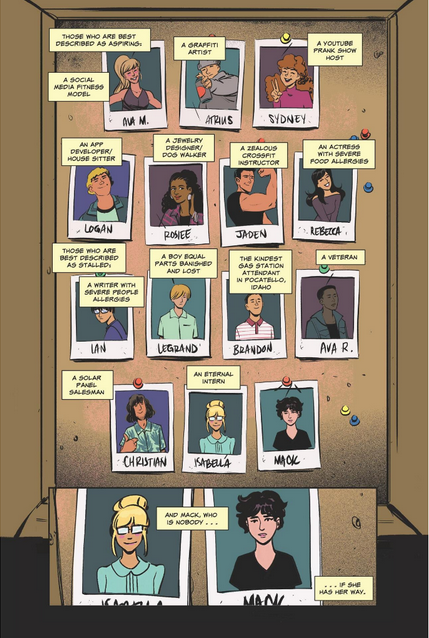
Mack signs up and soon finds herself in an abandoned amusement park with thirteen strangers. The rules are simple. Hide during the day, and be the last person found. Of course, this is nothing but a lie. There will be no winners, only victims.
What works
The first thing we have to talk about is how Hide the graphic novel compares to Hide, the original book. Of course, there wasn’t going to be enough room for every single part of the story. There were some cuts. But it doesn’t feel like anything essential was cut here. The characters remain the same. The storyline is still there, sans any structural issues. Often, this is a difficult thing to do. Some stories don’t translate from one medium to another. But Peterson did a wonderful job.
Of course, we can’t talk about a graphic novel without talking about the art. And the art in this book is fantastic. The colors are rich and vibrant. Everything looks exactly like one might picture it when reading the novel.
Except for the monster, which I have to admit I pictured more like a Rat Creature from Bone.
My favorite part was the journal entries. I loved the cryptic sigils that are scribbled over the page without explanation. I loved the different handwriting. I loved the clippings of newspapers and pictures. The whole thing was just wonderfully, eerily, immersive.
Finally, I want to point out that Hide is a great graphic novel even if you’ve never read the book, and never intend to. This is not a companion for the book. It tells the story all on its own. And yes, reading a graphic novel is just as valid as reading any other novel. This is just a good story, with good artwork. No other reading is necessary.
What didn’t work
There was only one thing I didn’t love about Hide. And that was the ending.
It’s usually the ending.
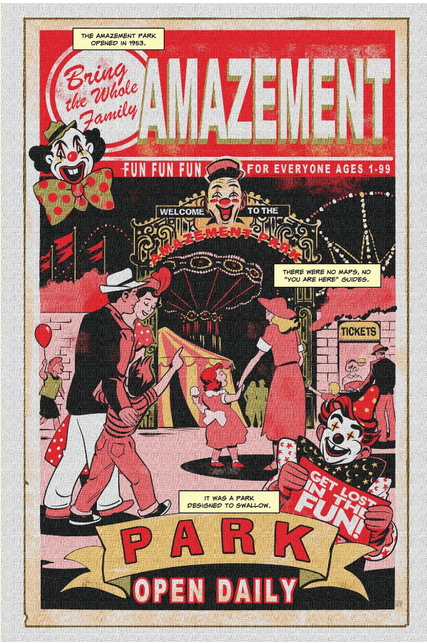
In the novel, the ending is ambiguous but satisfying. This ending was, without ruining it, a little more ambiguous. There are questions I really wanted answers for that I didn’t get. There is at least one character that I’d like to know about. Are they okay? I don’t know. And this ending doesn’t even really give us a hint. All we can do is hope.
If you are going to be picking this up for a younger person, be aware that there is some rough language. There are also a few graphic scenes of violence, so if that’s the sort of thing that will get you banned from further holiday events, be aware. But if you have a tween or teen who needs to be encouraged to delve into the creepy side, Hide is a great way to do it. Of course, there’s no shame in just reading it yourself.
 (4.5 / 5)
(4.5 / 5)
Book Reviews
Vermis II: Mist & Mirrors, a Book Review
Vermis II: Mist & Mirrors is a graphic novel by Plastiboo, acting as the “official guide for a game that doesn’t exist.”
Published
7 months agoon
September 17, 2024Vermis II: Mist & Mirrors is a graphic novel by Plastiboo. The team behind the work includes Plastiboo as the artist, Hollow Press as the publisher, Michele Nitri as the editor, Christian Dolz Bayarri as the graphic designer, Marco Cirillo Pedri as the graphic supervisor, and E.R. as the English editor and proofreader. The Vermis collection seems sold out in its current editions, but I still recommend ordering from the original publisher, Hollow Press.
Who stares back from the dark glass? The Wayfarer travels–cursed and haunted by their past–through the distant lands and places within the Mist & Mirrors. Endure a corrupt world and struggle to fend off the curses that mark you. Venture forth, Wayfarer, and perhaps find peace and salvation.

What I Like about Vermis II: Mist & Mirrors
The premise remains an “official guide” to a game that does not exist. However, one key distinction that stands out is the corrosion of this “official guide” mark, suggesting Mist & Mirrors centers itself as a graphic novel. In this sense, it more accurately hits its vision while providing an engaging story.
Mist & Mirrors places its character selection at the end of the graphic novel, instead, choosing a character and allowing the reader to follow that journey. While this moves away from the “official guide” concept, it better fleshes out the world and creates a more independent product.
Where Vermis I held a heavy retro-game aesthetic, Vermis II takes this to the next level while adding a wider range of color than the original. Not only does this add more aesthetic variety, but it also vastly improves readability. My greatest critique of the first graphic novel was the general lack of readability that impacted the experience, but Mist & Mirrors seems to take this to heart. Beyond the variety and improvement, the design changes the color themes to match the distinct lands the “Wayfarer” embarks on, giving a direct purpose to the changes.
On starting the graphic novel, I half expected a spiritual successor set in a new world. While its setting certainly differs from the original, Mist & Mirrors expands on the lore and history. In fact, the exploration of Mist & Mirrors adds value to the original and encourages a re-read. Honestly, that’s what all sequels strive (or should strive) to succeed.
Despite the colorful innovation, Vermis II: Mist & Mirrors delivers that same bleak horror popularized by Dark Souls. It still wears its inspirations on its sleeves while better communicating its “game mechanics.”

Tired Tropes and Triggers
Again, there aren’t many points worth mentioning regarding tropes or triggers. As the graphic novel takes themes and trends from the Soulslike genre, it’s dark and bleak but not overwhelmingly so.
Payment and delivery (for American audiences) still come with a 15 to 45-day wait period with little room for verification or updates. The process through PayPal remains seamless, and I received the novel within the timeframe, but it’s a consideration.
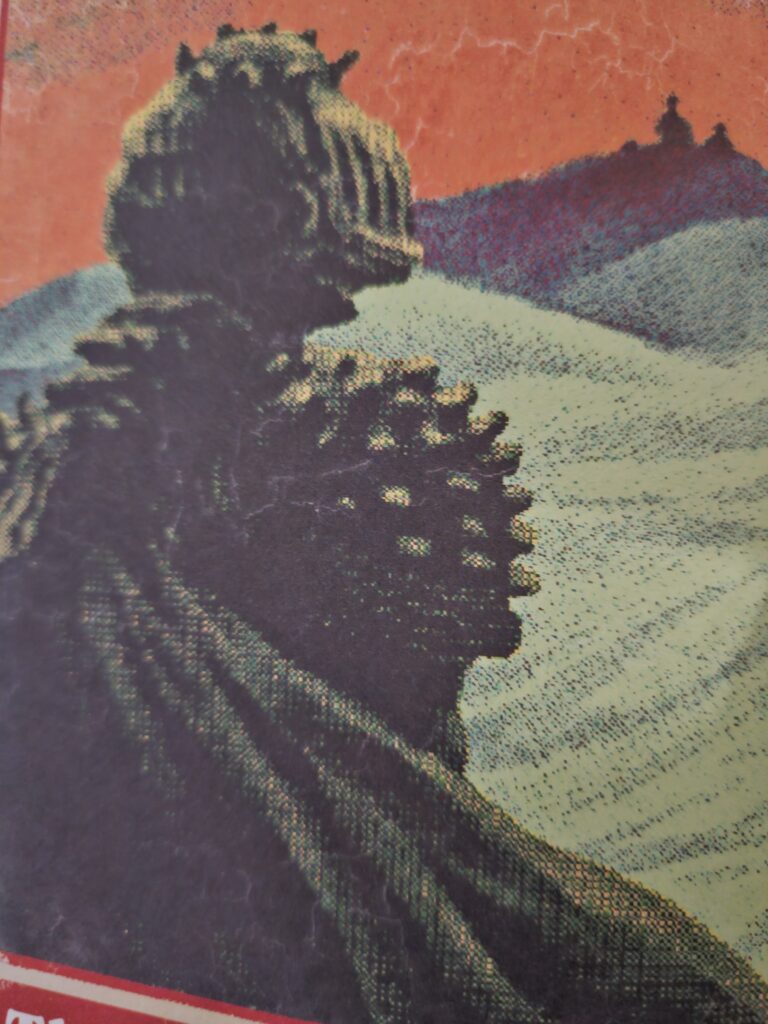
What I Dislike about Vermis II: Mist & Mirrors
While there are notable points to mention in this section, Mist & Mirror vastly mitigates Vermis I’s core issues. However, that isn’t inherently the same as fixing them in some cases. For example, readability remains a slight issue. I will emphasize it as a slight issue with the vast improvements implemented.
For those fans of the specific niche that Vermis aims to deliver, Mist & Mirrors tones down the “official guide” aspect. Instead, it favors a more straightforward narrative that follows a specific character. This brings life to the “game world” and makes an independent product but limits Vermis I’s game guide concept.
On a more personal note, I did enjoy the concept of Vermis I’s classes over the classes of Mist & Mirrors. Naturally, there are some interesting concepts, but nothing haunts me like the Infant Seeker or Rat Man. However, the new choices seem to provide a stronger narrative and backstory.
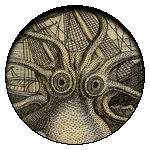
Final Thoughts
Vermis II: Mist & Mirrors vastly improves in many aspects of the original, telling a story set in its bleak and fascinating world. While it does veer from the original concept, it does so to make a more independent product. If you are looking to lose yourself in a strange world or dive deeper into Vermis’ underexplored lore, Mist & Mirrors seems tailor-made for you.
Published in April of this year, Bad Dreams in The Night is a collection of horror comics by the artist and author Adam Ellis. With the description stating that it is a graphic novel version of Scary Stories to Tell in the Dark, I had to get my hands on it. And it did not disappoint.
The stories
Bad Dreams in the Night consists of eleven short horror stories. I honestly don’t think there’s a bad one in the whole bunch. So let’s just highlight a few.
Easily my favorite story in the book was Little House in the Sea. It’s a sweet, eerie little tale that seems like a pinprick view into a dark and horrifying world. It left me with so many questions that I fear will never have answers. The story is about a young woman and her mother, who live on a little island all alone. The young woman is never to ask about what is on the other side of the sea. Then, her mother dies. And everything changes, but not by a lot.
Green Ribbon was another great story. It’s a retelling of the classic Girl With a Ribbon story from the original Scary Stories book, in which a man is confused and eventually angry that the love of his life wears a ribbon around her neck and won’t tell him why. I liked this updated version. It’s a stark reminder that just because we marry someone, we aren’t owed all of their secrets.
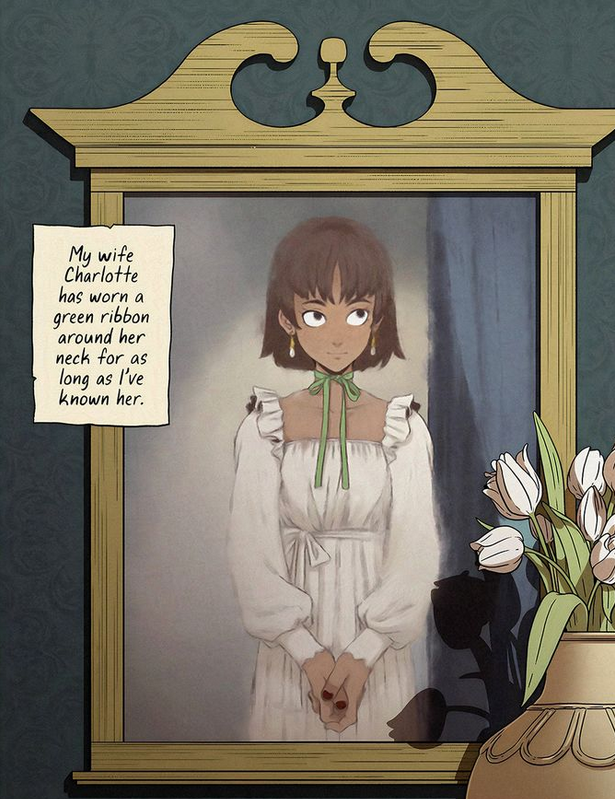
What worked
Of course, the first thing I have to point out about Bad Dreams in the Night is the fantastic artwork. Ellis was a cartoonist first, and it shows.
The artwork is part of the storytelling as well. The best example of this is the story Better Kate Than Never. The younger sister character, Taffy, has such an animated face during the scenes with a ‘studio audience’. When she is just herself, her face is flat, and far more mature than we’d expect for a girl her age.
Though, I suppose based on the story, she might be any age.
Another really enjoyable thing was the mini-essays at the end of each story. As a creator myself, I love the little peeks into the creative process. I know how I come up with stories. But it’s different for everyone, and the story behind the story is often just as fun.
Finally, I have to praise a feature that applies to Ellis’s work overall, not just this book. Whenever he writes scary stories (and he has posted quite a few on his social media) they are a fascinating blend of cute and horrifying. The artwork always has a lovely, innocent, cartoonish look. The children always look like cartoon children, with exaggerated large heads and wide circular eyes.
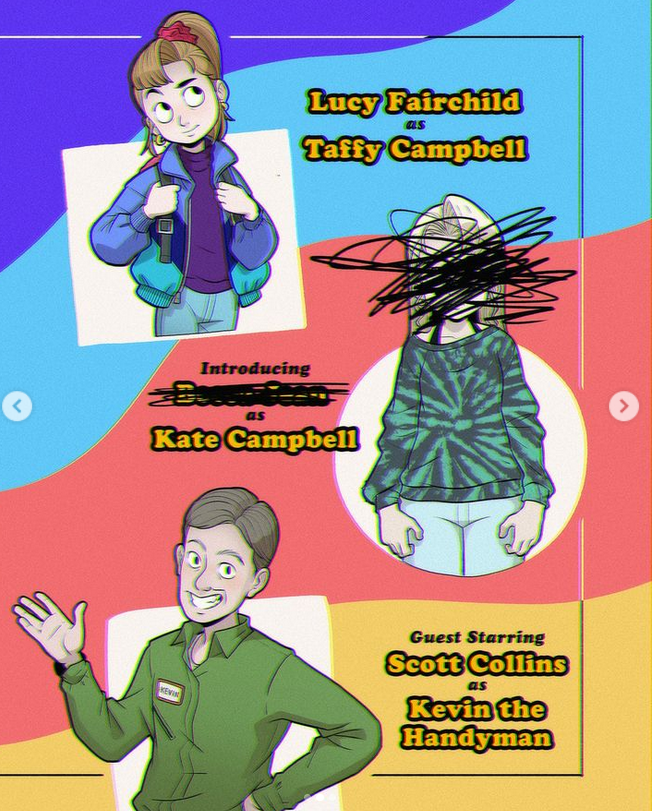
At the same time, Ellis doesn’t pull any punches when it comes to the blood and gore. One story in particular, Milk Door, is a perfect example of this. I don’t want to spoil the ending for you, but it is graphic, horrifying, and wonderful.
What (kind of) didn’t work
I only have one issue with this book. If you follow Ellis on social media, you’ve likely seen at least some of these stories before.
Though, even as I say this, I’m not sure what could have been done about it. Only the beginnings were shown on Instagram. This was a marketing tactic and an effective one. You get the setup for free, but you have to read the book for the punchline.
Bad Dreams in the Night was a really enjoyable way to spend a few hours. In the end, my only real complaint is that it could have been longer. But of course, that is one of the chief rules of entertainment. Always leave people wanting more.
(usr 5)
By the way, if you like this you might enjoy my haunted apartment novella, Quiet Apocalypse. The main character is a modern witch, and I share some real magic in this fictional story of an unexpected end of the world.

